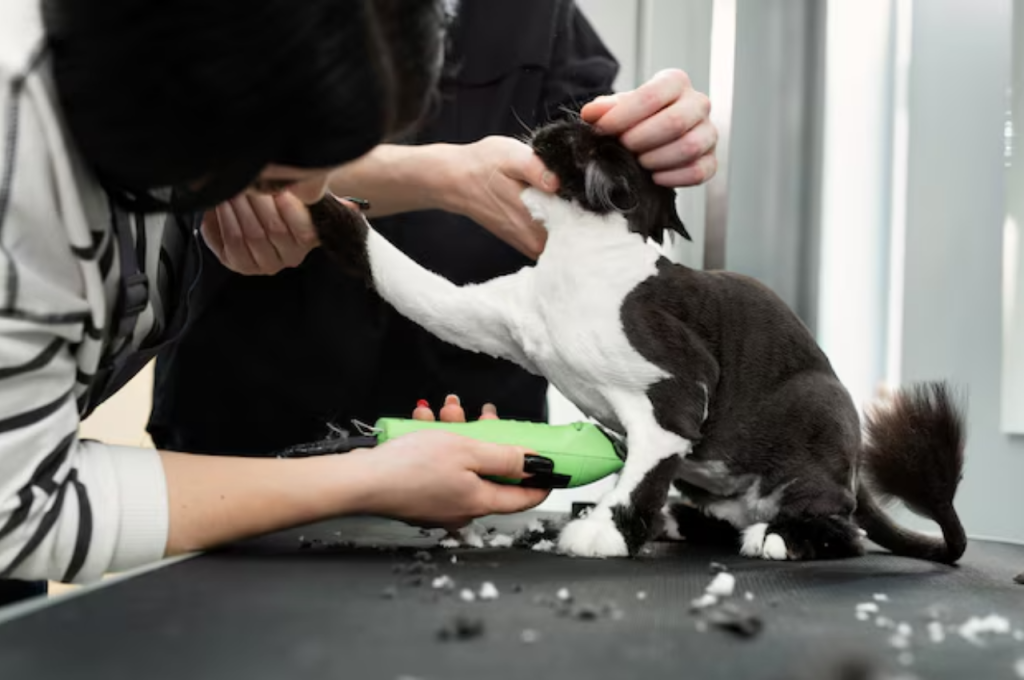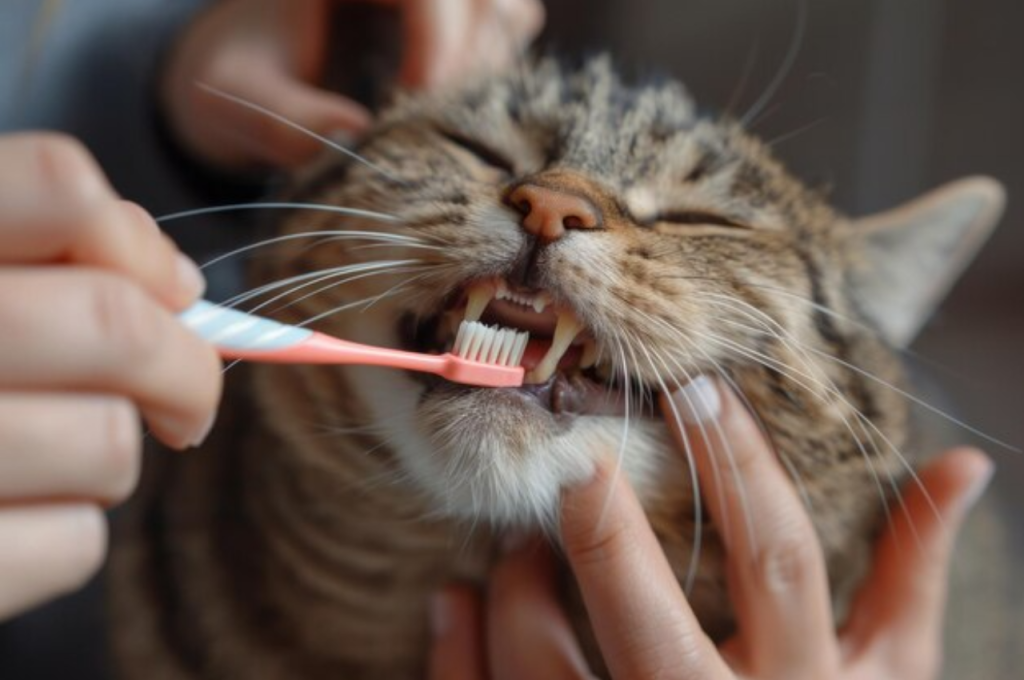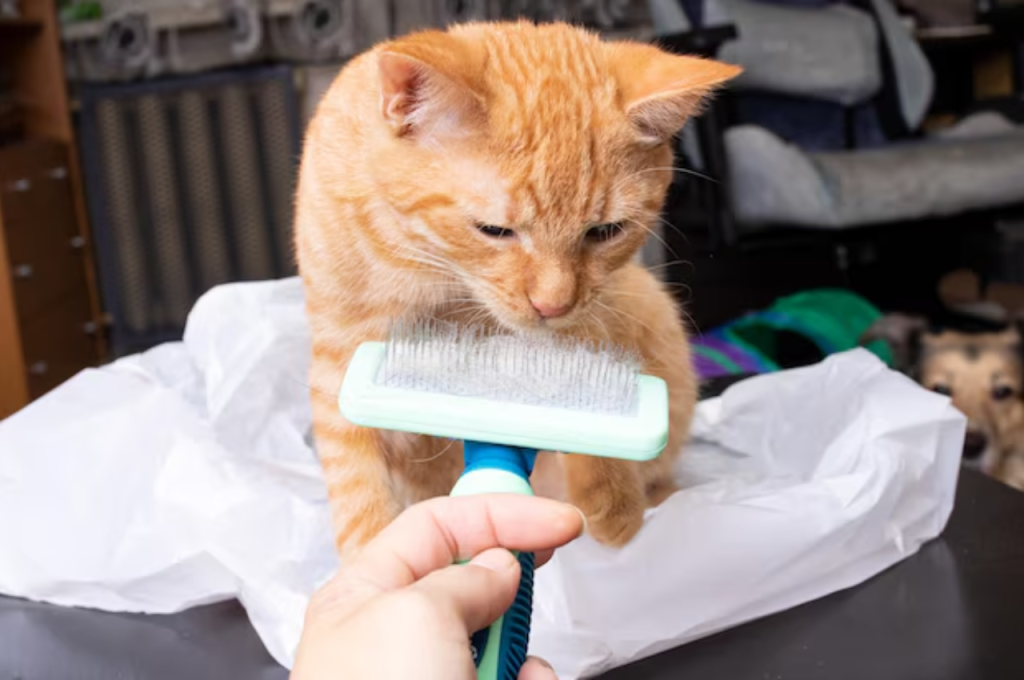Cat grooming includes brushing, bathing, nail trimming, and ear cleaning to maintain a cat’s hygiene and appearance. These grooming tasks are essential for keeping a cat’s coat clean, removing tangles and mats, preventing hairballs, and promoting overall well-being.
Regular grooming helps to distribute natural oils throughout the cat’s fur, keeping it healthy and reducing shedding. It also allows for the early detection of any skin issues or abnormalities. Proper nail trimming prevents painful overgrowth or splitting, while ear cleaning prevents infections. Grooming sessions also provide an opportunity to bond with your cat and monitor their overall health. By taking care of these grooming needs, you can ensure your cat stays clean, comfortable, and happy.
Introduction to Cat Grooming
When it comes to keeping your feline friend healthy and happy, grooming plays a crucial role. Cat grooming involves a range of activities that go beyond just keeping your pet looking good. From maintaining their coat to promoting good hygiene, grooming is an essential aspect of caring for your cat.

Why Grooming is Vital
Grooming is vital for your cat’s overall well-being. It helps in preventing mats and tangles in their fur, which can lead to skin irritation and discomfort. Regular grooming also allows you to check for any skin issues or abnormalities that may require veterinary attention. Additionally, grooming helps to reduce shedding and minimize hairballs, promoting a healthier living environment for both you and your pet.
Types of Cat Coats
Cats have different coat types that require specific grooming techniques. Short-haired cats need regular brushing to remove loose hair, while long-haired breeds may need more frequent grooming to prevent matting. Understanding your cat’s coat type is essential for providing the right grooming care to keep them comfortable and healthy.
Basics of Cat Grooming
Grooming is an essential part of maintaining your cat’s health and well-being. It involves various activities that not only keep your feline friend looking good but also contribute to their overall hygiene. Understanding the basics of cat grooming can help you establish a regular routine to ensure your cat stays clean, comfortable, and healthy.
Brushing Techniques
Regular brushing is crucial for keeping your cat’s coat in good condition. It helps to remove loose fur, prevent matting, and reduce hairballs. Different cat breeds have specific grooming needs, so selecting the right brush for your cat’s coat type is important. Short-haired cats may require a soft brush, while long-haired breeds might need a more robust tool to tackle tangles and knots.
When brushing your cat, use gentle, slow strokes to avoid causing discomfort. Pay special attention to areas prone to matting, such as behind the ears and under the legs. Brushing your cat regularly also provides an opportunity to check for any skin issues, lumps, or parasites.
Bathing Your Cat
Bathing a cat is not always necessary, as they are generally adept at keeping themselves clean. However, there are instances when a bath is beneficial, such as when your cat has gotten into something sticky or has a skin condition that requires treatment. If you decide to bathe your cat, it’s essential to use a mild, cat-specific shampoo and to introduce them to the bathing process gradually to avoid stress.
Before bathing, brush your cat to remove any tangles and mats and trim their nails to prevent scratching. Use lukewarm water and be gentle when wetting and rinsing your cat. Afterward, pat them dry with a towel and provide treats or praise to create positive associations with bathing.
Nail Care for Cats
When it comes to cat grooming, nail care is a crucial aspect that requires attention. Regular nail trimming not only prevents your feline friend from getting their claws caught in furniture or carpeting but also helps maintain their overall health and well-being.
Trimming Tips
Trimming your cat’s nails can be a challenging task, especially if your pet is not accustomed to the process. To make the experience less stressful, it’s important to introduce your cat to the nail-trimming routine gradually. Start by gently handling their paws and getting them comfortable with the sensation.
Safety Measures
When trimming your cat’s nails, it’s essential to use specialized pet nail clippers to avoid causing any discomfort or injury. Be cautious not to cut the quick, which is a sensitive blood vessel located inside the nail. If you’re unsure about the process, consider seeking guidance from a professional groomer or veterinarian.
Ear and Eye Care
Cat grooming includes ear and eye care, ensuring proper hygiene and health for your feline friend. Regular cleaning and inspection help prevent infections and maintain their overall well-being. A thorough grooming routine promotes a happy and healthy cat.
Ear and Eye Care are essential parts of cat grooming. Proper care of the eyes and ears of your feline friend can prevent infections and other health issues. Cleaning procedures for these areas should be done regularly. Signs of infections should be monitored to ensure early detection and treatment. In this section, we will discuss the cleaning procedures and signs of infections to help you provide the best care for your cat’s eyes and ears.
Cleaning Procedures
Cleaning your cat’s eyes and ears should be done with care. Here are some tips to follow:
- Use a clean, damp cloth to wipe around the eyes and ears.
- Never use cotton swabs or Q-tips in the ears as they can push debris further into the ear canal and cause damage.
- For excessive earwax or debris, use a cat-specific ear cleaner recommended by your veterinarian.
- For cats with long hair, trim the hair around the eyes to prevent irritation and matting.
Signs of Infections
Regular cleaning of your cat’s eyes and ears can help detect signs of infections early. Here are some signs to watch out for:
| Signs of Eye Infections | Signs of Ear Infections |
| Redness or swelling around the eyes | Scratching or rubbing of the ears |
| Discharge from the eyes | Shaking of the head |
| Cloudiness or changes in eye color | Unpleasant odor from the ears |
| Changes in behavior, such as lethargy or loss of appetite | Increased sensitivity or pain when touching the ears |
If you notice any of these signs, it’s best to consult with your veterinarian immediately. Early detection and treatment can help prevent further health issues for your furry friend. Regular ear and eye care is crucial to the overall health and well-being of your cat. By following proper cleaning procedures and monitoring for signs of infections, you can ensure your feline friend stays happy and healthy.
Dental Hygiene for Felines
Cat grooming encompasses brushing, nail trimming, and dental hygiene for felines to maintain their overall health. Regular dental care is crucial for cats, including teeth brushing and professional cleanings to prevent dental issues and ensure their well-being.

Brushing Techniques
Proper brushing techniques are essential for maintaining your cat’s dental hygiene. To brush your cat’s teeth, start by using a cat-specific toothbrush and toothpaste, as human products can be harmful. Gently lift your cat’s lip and brush in small, circular motions, focusing on the gum line where plaque and tartar often accumulate. Gradually introduce the brushing process, beginning with short sessions and rewarding your cat with treats or praise to create a positive experience. Regular brushing helps prevent dental issues like gingivitis, bad breath, and tooth decay, supporting overall health. Aim to brush your cat’s teeth at least two to three times a week to keep their mouth clean and healthy.
Choosing The Right Products
Choosing the right products is essential for maintaining your cat’s dental hygiene. Opt for cat-specific toothbrushes and toothpaste, as human products can be harmful to cats. Look for toothbrushes with soft bristles and toothpaste in flavors that appeal to cats, like poultry or seafood, to make the process more comfortable and enjoyable.
Dental treats and water additives can also support oral health by reducing plaque and tartar buildup. Regularly using the right products helps prevent dental issues such as gingivitis, tooth decay, and bad breath, promoting overall health and comfort for your feline friend. Always consult your veterinarian for recommendations on the best dental products suited to your cat’s needs.
Dealing with Fur Issues
Dealing with fur issues is a crucial aspect of cat grooming. It involves handling mats and tangles as well as finding shedding solutions to keep your feline friend looking and feeling their best.
Handling Mats and Tangles
Mats and tangles can be uncomfortable for your cat. Use a metal comb to gently work through them. Trimming may be necessary for stubborn mats.
Shedding Solutions
Regular brushing helps reduce shedding. Opt for a slicker brush for short-haired cats and a de-shedding tool for long-haired breeds. Supplements can also aid in reducing shedding.
Professional Grooming
Professional cat grooming includes a variety of services such as bathing, brushing, trimming nails, cleaning ears, and removing mats and tangles. Grooming can help maintain your cat’s health, hygiene, and appearance, while also preventing potential health issues.
Cats are known for their cleanliness, but they still require grooming to maintain their hygiene and health. While regular brushing and bathing can help keep your cat clean, there are times when professional grooming is necessary. Professional cat grooming involves a range of services, from nail trimming to haircuts, to ensure your feline friend looks and feels their best.
When to Consider Selecting a Groomer
If you’re unsure whether your cat needs professional grooming, there are a few signs to look out for. Firstly, if your cat has long hair, it may be prone to matting and tangling, which can be difficult to manage without professional help. Additionally, if your cat has any skin conditions or parasites, a groomer can help remove any debris or pests that may be causing discomfort. Lastly, if your cat is elderly or has mobility issues, a groomer can provide assistance with grooming tasks that may be difficult for you to perform at home.
Services Offered by Professional Cat Groomers
Professional cat groomers offer a range of services to keep your feline friends looking and feeling their best. Some of the most common services include:
- Nail trimming
- Ear cleaning
- Bathing and blow-drying
- Brushing and de-matting
- Haircutting and styling
These services not only improve your cat’s appearance but also promote good health by removing debris and parasites that can cause infections and other health issues.
Choosing The Right Groomer
When selecting a professional groomer for your cat, it’s important to do your research. Look for a groomer who is experienced with cats and has a good reputation in the community. Additionally, make sure the groomer is licensed and insured and uses safe and humane grooming practices. You can also ask for recommendations from other pet owners or your veterinarian to find a reputable groomer in your area.
In conclusion, professional cat grooming is an important part of keeping your feline friend healthy and happy. By knowing when to consider selecting a groomer, understanding the services offered, and choosing the right groomer for your cat, you can help ensure that your furry friend receives the best possible care.
Diy Grooming Tips
Cat grooming includes brushing their coat to remove loose hair and prevent mats, trimming their nails, cleaning their ears, and brushing their teeth. Regular grooming helps keep your cat clean and healthy, reducing shedding and preventing hairballs.

If you’re a cat owner, you know how important it is to keep your feline friend well-groomed. Regular grooming ensures that your cat’s coat stays healthy and shiny, and it also helps to prevent hairballs and other health issues. While professional grooming services are available, it’s also possible to groom your cat at home. In this post, we’ll provide you with some DIY grooming tips that you can use to keep your cat looking and feeling great.
Homemade Grooming Solutions
When it comes to grooming your cat at home, there are a few homemade solutions that you can use to keep your cat’s coat healthy and shiny. One of the most popular solutions is a mixture of water and apple cider vinegar. This solution can be used to clean your cat’s fur and to help prevent fleas and ticks. Another popular solution is a mixture of baking soda and water. This solution can be used to clean your cat’s ears and to help prevent ear mites.
Routine Grooming Schedule
Establishing a routine grooming schedule is essential for keeping your cat’s coat healthy and shiny. A typical grooming schedule should include brushing your cat’s coat at least once a week, cleaning their ears once a month, and trimming their nails every six to eight weeks. It’s also important to give your cat regular baths, especially if they have long hair or are prone to shedding.
Grooming your cat at home can be a great way to bond with your pet while also ensuring that they stay healthy and happy. By following these DIY grooming tips, you can keep your cat looking and feeling great without having to spend a lot of money on professional grooming services. Remember to establish a routine grooming schedule, use homemade grooming solutions when possible, and always be gentle when grooming your cat.
Conclusion
To sum up, cat grooming encompasses various essential tasks that contribute to the overall well-being of your feline companion. From regular brushing and nail trimming to ear cleaning and dental care, these practices not only keep your cat’s coat shiny and free from tangles but also promote good hygiene and prevent potential health issues.
By investing time and effort into grooming your cat, you can ensure they remain healthy, happy, and beautiful. So, prioritize cat grooming as an integral part of your pet care routine.
